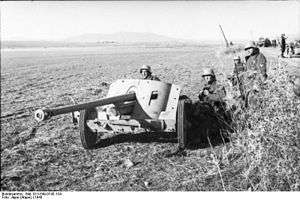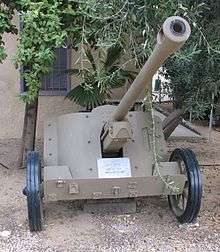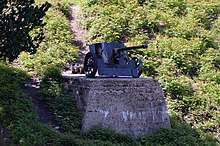5 cm Pak 38
The 5 cm Pak 38 (L/60) (5 cm Panzerabwehrkanone 38 (L/60)) was a German anti-tank gun of 50 mm calibre. It was developed in 1938 by Rheinmetall-Borsig AG as a successor to the 3.7 cm Pak 36, and was in turn followed by the 7.5 cm Pak 40.
| 5 cm Panzerabwehrkanone 38 (L/60) | |
|---|---|
 German soldiers with 5cm Pak 38 during the Tunisian Campaign | |
| Type | Panzerabwehrkanone |
| Place of origin | Nazi Germany |
| Service history | |
| In service | 1940–1945 |
| Used by | Nazi Germany Italy Finland Romania |
| Wars | World War II Continuation War |
| Production history | |
| Designed | 1937–1939 |
| Manufacturer | Rheinmetall-Borsig |
| Unit cost | 10600 Reichmark |
| Produced | 1940–1943 |
| No. built | 9,566[1] |
| Specifications | |
| Mass |
|
| Length | 4.75 m (15.6 ft) |
| Barrel length | 300 cm (120 in) bore (60 calibres) |
| Width | 1.85 m (6 ft 1 in) |
| Height | 1.05 m (3 ft 5 in) |
| Crew | 5 |
| Shell | Fixed QF 50×419mm R 5 cm Pzgr. |
| Shell weight | 2.25 kg (4 lb 15 oz)[3] |
| Caliber | 50 mm (2.0 in) |
| Action | Semi-automatic |
| Breech | Horizontal sliding-wedge |
| Recoil | Hydro-pneumatic[2] |
| Carriage | Split-trail |
| Elevation | -8° to +27°[2] |
| Traverse | 65° |
| Rate of fire | 13 rounds/min |
| Muzzle velocity | 550-1,130 m/s (1,804-3,707 ft/s) |
| Maximum firing range | 2,700 m (3,000 yd) |
| Feed system | Manual |
| Sights | Z.F. 3x8° |
Successor to the Pak 36
After the Spanish Civil War, the German authorities started to think that a new anti-tank gun would be needed, even though the 3.7 cm Pak 36 had proven to be very successful. They asked Rheinmetall-Borsig to produce a new and more capable AT-gun. They first designed the Pak 37 in 1935, but the German authorities did not approve it because of its low capabilities. Rheinmetall-Borsig were forced to create a new gun under the designation Pak 38, which fitted a new and longer L/60 barrel and was approved for mass production in 1939.
Service


The Pak 38 was first used by the German forces during the Second World War in April 1941. When the Germans faced Soviet tanks in 1941 during Operation Barbarossa, the Pak 38 was one of the few early guns capable of penetrating the 45 mm (1.8 in) sloped armor of the T-34's hull at close range. The gun was also equipped with Panzergranate 40 APCR shots with a hard tungsten carbide core, in an attempt to penetrate the armor of the heavier KV-1 tank.
Although it was replaced by more powerful weapons, it remained a useful weapon and remained in service with the Wehrmacht until the end of the war.
The Pak 38 carriage was also used for the 7.5 cm Pak 97/38 and the 7.5 cm Pak 50 guns.
Romania imported 110 Pak 38s in March 1943. The guns remained in service with the Romanian Armed Forces until 1954, when the 57 mm anti-tank gun M1943 (ZiS-2) replaced them.[4]
Performance
| AP | |
| Range | Contact angle 30° |
| 100 m (110 yd) | 100 mm (3.9 in) |
| 500 m (550 yd) | 79 mm (3.1 in) |
| 1,000 m (1,100 yd) | 60 mm (2.4 in) |
| 1,500 m (1,600 yd) | 45 mm (1.8 in) |
| APC | |
| 100 m (110 yd) | 96 mm (3.8 in) |
| 500 m (550 yd) | 79 mm (3.1 in) |
| 1,000 m (1,100 yd) | 62 mm (2.4 in) |
| 1,500 m (1,600 yd) | 49 mm (1.9 in) |
| APCR | |
| 100 m (110 yd) | 149 mm (5.9 in) |
| 500 m (550 yd) | 108 mm (4.3 in) |
| 1,000 m (1,100 yd) | 72 mm (2.8 in) |
| 1,500 m (1,600 yd) | 48 mm (1.9 in) |
References
- Battistelli, Pier Paolo (2008) Panzer Divisions: The Eastern Front 1941-43
- Foss, Christopher (1977). Jane's pocket book of towed artillery. New York: Collier. p. 15. ISBN 0020806000. OCLC 911907988.
- Chamberlain, Peter (1974). Anti-tank weapons. Gander, Terry. New York: Arco Pub. Co. p. 13. ISBN 0668036079. OCLC 1299755.
- Stroea, Adrian; Băjenaru, Gheorghe (2010). Artileria româna în date si imagini [Romanian artillery in data and images] (PDF) (in Romanian). Editura Centrului Tehnic-Editorial al Armatei. p. 84. ISBN 978-606-524-080-3.
- Bird, Lorrin; Lingston, Robert (2001). World War II Ballistics: Armor and Gunnery. Albany, NY USA: Overmatch Press. p. 61. OCLC 71143143.
- Gander, Terry; Chamberlain, Peter (1979). Weapons of the Third Reich: An Encyclopedic Survey of All Small Arms, Artillery and Special Weapons of the German Land Forces 1939–1945. New York: Doubleday. ISBN 0-385-15090-3.
- Hogg, Ian V. (1997). German Artillery of World War Two (2nd corrected ed.). Mechanicsville: Stackpole Books. ISBN 1-85367-480-X.